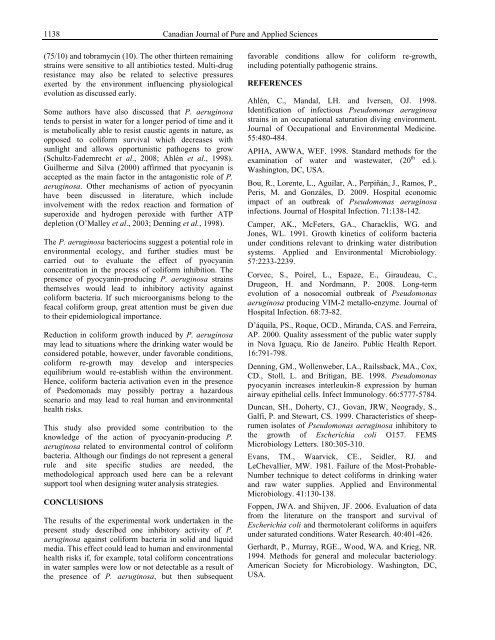Download (5Mb) - Covenant University Repository
Download (5Mb) - Covenant University Repository
Download (5Mb) - Covenant University Repository
You also want an ePaper? Increase the reach of your titles
YUMPU automatically turns print PDFs into web optimized ePapers that Google loves.
1138<br />
(75/10) and tobramycin (10). The other thirteen remaining<br />
strains were sensitive to all antibiotics tested. Multi-drug<br />
resistance may also be related to selective pressures<br />
exerted by the environment influencing physiological<br />
evolution as discussed early.<br />
Some authors have also discussed that P. aeruginosa<br />
tends to persist in water for a longer period of time and it<br />
is metabolically able to resist caustic agents in nature, as<br />
opposed to coliform survival which decreases with<br />
sunlight and allows opportunistic pathogens to grow<br />
(Schultz-Fademrecht et al., 2008; Ahlén et al., 1998).<br />
Guilherme and Silva (2000) affirmed that pyocyanin is<br />
accepted as the main factor in the antagonistic role of P.<br />
aeruginosa. Other mechanisms of action of pyocyanin<br />
have been discussed in literature, which include<br />
involvement with the redox reaction and formation of<br />
superoxide and hydrogen peroxide with further ATP<br />
depletion (O’Malley et al., 2003; Denning et al., 1998).<br />
The P. aeruginosa bacteriocins suggest a potential role in<br />
environmental ecology, and further studies must be<br />
carried out to evaluate the effect of pyocyanin<br />
concentration in the process of coliform inhibition. The<br />
presence of pyocyanin-producing P. aeruginosa strains<br />
themselves would lead to inhibitory activity against<br />
coliform bacteria. If such microorganisms belong to the<br />
feacal coliform group, great attention must be given due<br />
to their epidemiological importance.<br />
Reduction in coliform growth induced by P. aeruginosa<br />
may lead to situations where the drinking water would be<br />
considered potable, however, under favorable conditions,<br />
coliform re-growth may develop and interspecies<br />
equilibrium would re-establish within the environment.<br />
Hence, coliform bacteria activation even in the presence<br />
of Psedomonads may possibly portray a hazardous<br />
scenario and may lead to real human and environmental<br />
health risks.<br />
This study also provided some contribution to the<br />
knowledge of the action of pyocyanin-producing P.<br />
aeruginosa related to environmental control of coliform<br />
bacteria. Although our findings do not represent a general<br />
rule and site specific studies are needed, the<br />
methodological approach used here can be a relevant<br />
support tool when designing water analysis strategies.<br />
CONCLUSIONS<br />
The results of the experimental work undertaken in the<br />
present study described one inhibitory activity of P.<br />
aeruginosa against coliform bacteria in solid and liquid<br />
media. This effect could lead to human and environmental<br />
health risks if, for example, total coliform concentrations<br />
in water samples were low or not detectable as a result of<br />
the presence of P. aeruginosa, but then subsequent<br />
Canadian Journal of Pure and Applied Sciences<br />
favorable conditions allow for coliform re-growth,<br />
including potentially pathogenic strains.<br />
REFERENCES<br />
Ahlén, C., Mandal, LH. and Iversen, OJ. 1998.<br />
Identification of infectious Pseudomonas aeruginosa<br />
strains in an occupational saturation diving environment.<br />
Journal of Occupational and Environmental Medicine.<br />
55:480-484.<br />
APHA, AWWA, WEF. 1998. Standard methods for the<br />
examination of water and wastewater, (20 th ed.).<br />
Washington, DC, USA.<br />
Bou, R., Lorente, L., Aguilar, A., Perpiñán, J., Ramos, P.,<br />
Peris, M. and Gonzáles, D. 2009. Hospital economic<br />
impact of an outbreak of Pseudomonas aeruginosa<br />
infections. Journal of Hospital Infection. 71:138-142.<br />
Camper, AK., McFeters, GA., Characklis, WG. and<br />
Jones, WL. 1991. Growth kinetics of coliform bacteria<br />
under conditions relevant to drinking water distribution<br />
systems. Applied and Environmental Microbiology.<br />
57:2233-2239.<br />
Corvec, S., Poirel, L., Espaze, E., Giraudeau, C.,<br />
Drugeon, H. and Nordmann, P. 2008. Long-term<br />
evolution of a nosocomial outbreak of Pseudomonas<br />
aeruginosa producing VIM-2 metallo-enzyme. Journal of<br />
Hospital Infection. 68:73-82.<br />
D’áquila, PS., Roque, OCD., Miranda, CAS. and Ferreira,<br />
AP. 2000. Quality assessment of the public water supply<br />
in Nova Iguaçu, Rio de Janeiro. Public Health Report.<br />
16:791-798.<br />
Denning, GM., Wollenweber, LA., Railssback, MA., Cox,<br />
CD., Stoll, L. and Britigan, BE. 1998. Pseudomonas<br />
pyocyanin increases interleukin-8 expression by human<br />
airway epithelial cells. Infect Immunology. 66:5777-5784.<br />
Duncan, SH., Doherty, CJ., Govan, JRW, Neogrady, S.,<br />
Galfi, P. and Stewart, CS. 1999. Characteristics of sheeprumen<br />
isolates of Pseudomonas aeruginosa inhibitory to<br />
the growth of Escherichia coli O157. FEMS<br />
Microbiology Letters. 180:305-310.<br />
Evans, TM., Waarvick, CE., Seidler, RJ. and<br />
LeChevallier, MW. 1981. Failure of the Most-Probable-<br />
Number technique to detect coliforms in drinking water<br />
and raw water supplies. Applied and Environmental<br />
Microbiology. 41:130-138.<br />
Foppen, JWA. and Shijven, JF. 2006. Evaluation of data<br />
from the literature on the transport and survival of<br />
Escherichia coli and thermotolerant coliforms in aquifers<br />
under saturated conditions. Water Research. 40:401-426.<br />
Gerhardt, P., Murray, RGE., Wood, WA. and Krieg, NR.<br />
1994. Methods for general and molecular bacteriology.<br />
American Society for Microbiology. Washington, DC,<br />
USA.

















